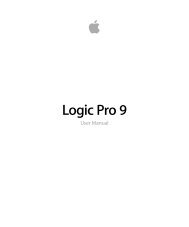Soundtrack Pro 3 Effects Reference (en).pdf - Help Library - Apple
Soundtrack Pro 3 Effects Reference (en).pdf - Help Library - Apple
Soundtrack Pro 3 Effects Reference (en).pdf - Help Library - Apple
You also want an ePaper? Increase the reach of your titles
YUMPU automatically turns print PDFs into web optimized ePapers that Google loves.
• If the project sample rate is 44.1 kHz, the options will be 22.05 kHz, 11.025 kHz, and<br />
5512.5 Hz.<br />
Changing the sample rate upward increases—or changing it downward decreases—the<br />
frequ<strong>en</strong>cy response (and l<strong>en</strong>gth) of the impulse response, and to a degree the overall<br />
sound quality of the reverb. Upward sample rate changes are of b<strong>en</strong>efit only if the original<br />
IR sample actually contains higher frequ<strong>en</strong>cies. Wh<strong>en</strong> you are reducing the sample rate,<br />
use your ears to decide if the sonic quality meets your needs.<br />
Note: Natural room surfaces—except concrete and tiles—t<strong>en</strong>d to have minimal reflections<br />
in the higher frequ<strong>en</strong>cy ranges, making the half-rate and full-rate IRs sound almost<br />
id<strong>en</strong>tical.<br />
Wh<strong>en</strong> you select half the sample rate, the impulse response becomes twice as long. The<br />
highest frequ<strong>en</strong>cy that can be reverberated will be halved. This results in a behavior that<br />
is much like doubling every dim<strong>en</strong>sion of a virtual room—multiplying a room’s volume<br />
by eight.<br />
Another b<strong>en</strong>efit of reducing the sample rate is that processing requirem<strong>en</strong>ts drop<br />
significantly, making half-sample rate settings useful for large, op<strong>en</strong> spaces.<br />
Activating the “preserve l<strong>en</strong>gth” button preserves the l<strong>en</strong>gth of the impulse response<br />
wh<strong>en</strong> the sample rate is changed. Manipulating these two parameters as you see fit can<br />
lead to interesting results.<br />
The lower sample rates can also be used for interesting tempo, pitch, and retro-digital<br />
sounding effects.<br />
If you are running Space Designer in a project that uses a higher sample rate than the<br />
impulse response, you may also want to reduce the impulse response sample rate. Make<br />
sure the “preserve l<strong>en</strong>gth” function is <strong>en</strong>abled. This cuts CPU power consumption without<br />
compromising reverb quality. There is no loss in reverb quality, because the impulse<br />
response does not b<strong>en</strong>efit from the higher project sample rate.<br />
You can make similar adjustm<strong>en</strong>ts while running in Synthesized IR mode. Most typical<br />
reverb sounds don’t feature an excessive amount of high frequ<strong>en</strong>cy cont<strong>en</strong>t. If you were<br />
running at 96 kHz, for example, you would need to make use of some deep lowpass<br />
filtering to obtain the mellow frequ<strong>en</strong>cy response characteristics of many reverb sounds.<br />
A better approach would be to first reduce the high frequ<strong>en</strong>cies by 1/2 or ev<strong>en</strong> 1/4 using<br />
the “sample rate” slider, and th<strong>en</strong> apply the lowpass filter. This conserves a considerable<br />
amount of CPU power.<br />
Setting Impulse Response L<strong>en</strong>gths in Space Designer<br />
You can use the L<strong>en</strong>gth parameter to set the l<strong>en</strong>gth of the impulse response—sampled<br />
or synthesized.<br />
136 Chapter 11 Space Designer Convolution Reverb
















